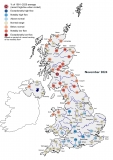Submitted by Katie Muchan on
October was a cool and very wet month for most, with a succession of frontal systems delivering persistent heavy rainfall across England and Wales. Although October rainfall for the UK was only marginally above average, there were substantial regional variations; the majority of England and Wales was characterised by notably wet weather, exceptionally so in parts of eastern England. This concluded an exceptionally wet summer and autumn so far (June‑October) in northern, central and eastern England; for the Severn-Trent region, it was the wettest June-October on record (in a series from 1910). River flows were substantially above average across most of England and Wales, with exceptionally high flows recorded throughout central areas and in parts of the north-east (many of which were also new October monthly mean flow maxima). Late October soil moisture deficits (SMDs) were near-zero across the UK (away from East Anglia). Correspondingly, groundwater levels in the majority of boreholes increased during October and were above normal or higher, with the exception of the Chalk of eastern England. The wet weather enabled reservoir replenishment (particularly those in the English Lowlands) and overall stocks for England & Wales were comfortably above average, and after five months of wet weather water resources are very healthy. Whilst there were some notably low groundwater levels in the Chalk of the Chilterns and East Anglia, the groundwater recharge season has started earlier than normal. Further wet weather and extreme rainfall totals in early November have caused significant flooding in parts of northern and central England, and the seasonal outlook for continued wet weather (particularly in the north and west) implies a high risk of further flooding this winter.
The full Hydrological Summary can be found here.



